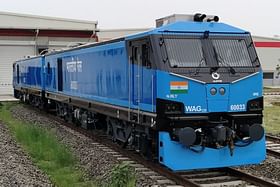As per the National Rail Plan and the Mission 3,000 MT, Indian Railways needs to ramp up its freight locomotive holding from the present 11,000 including diesel locomotives to at least 20,000 fully electric except for some strategic lines by 2030.
With the aim of increasing modal freight share from the present 30 per cent to 40-45 per cent by 2030, Indian Railways has undertaken an ambitious plan for increasing its rolling stock fleet with induction of high-powered freight locomotives and state-of-the-art wagons.
For heavy haul operations, the Railways has identified two freight locomotive platforms to cater to this wide spectrum of trailing loads – 12,000 HP and 9,000 HP.
As per the National Rail Plan and the Mission 3,000 MT, Indian Railways needs to ramp up its freight locomotive holding from the present 11,000 including diesel locomotives to at least 20,000 fully electric except for some strategic lines by 2030.
Accordingly, the Railways has ramped up its locomotive production
target to 1,300 for 2022-23 as against around 900 locomotives produced in
2020-21.
Besides the in-house locomotive manufacturing capacity at Chittaranjan Loco Works, the Railways in a JV with Alstom France will produce 12,000 HP at Madhepura in Bihar with a purchase guarantee of around 1,000 locomotives.
For producing 9,000 HP locomotives through a similar arrangement at Dahod workshop, the tender was awarded to Siemens.
For ramping up production of 12,000 HP locomotives, a tender for procurement of locomotives with an improved chassis design is likely to be opened next month.
The manufacturing facility for the 9000 HP locomotives is to be created at Dahod in Gujarat. The in-house manufacturing capacity at Chittaranjan would be used for converting existing 6000 HP locomotives to 9000 HP.
Operationally the railways freight transport in terms of trailing load can be
broadly categorised into:
- heavy load freight trains with carrying capacity of 6000 tons such as those carrying coal, iron ore , etc.;
- medium load trains with carrying capacity of 4000 tons such as those carrying food grain, cement, fertiliser, finished steel;
- double stack container etc. and light load freight trains with 3000 tons carrying capacity such as those carrying automobiles , single stack containers, etc.
- The light cargo trains with carrying capacity of 1500 tons such as parcel trains, kisan rail, carrying perishables etc.
However, it is for the first three types of freight trains – heavy, medium and light load that new state-of-the-art electric freight locomotive platforms are required.
The Railways has been substantially increasing its annual capital expenditure over the years to enhance both fixed infrastructure as well as increasing its fleet size in both wagons and locomotives.
Presently the Capex is nearly six times of what it was in 2013-14. The spending is not only limited to expanding the infrastructure in terms of volume but also improving productivity of assets through technological upgradation.
The Indian Railways, with the commissioning of the East and West Dedicated Freight Corridors (DFCs) along with third and fourth line works as identified in the National Rail Plan, and the Vision 2024 and Mission 3000 MT programmes, are virtually creating a separate rail network for freight trains.
This, along with three more DFC corridors in future , will also open up the possibility of having long haul operations as a norm which will only add to the permutations of possible trailing loads of freight trains.
Thus with such a variety of possible trailing loads to cater to in future, the railway operational planners have an onerous task in picking the ideal electric freight locomotive platform.
It is not just the trailing load and the vagaries of terrain that need to be kept in focus while deciding the right locomotive platform, but also energy efficiency and related issues of emission, regenerative braking etc.


